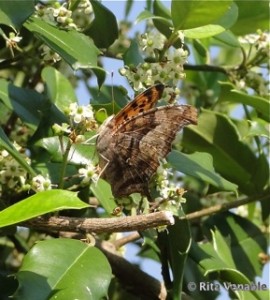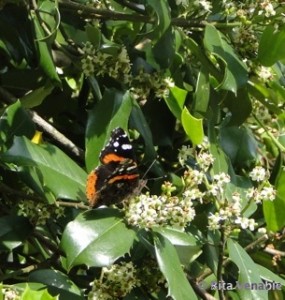One April morning I was walking along the sidewalk to our mailbox when I noticed something fluttering on the American holly (Ilex opaca) at the corner of the house. Temperatures outside were warm—about 70 degrees—and the sun was shining on the holly. The movement on the flowers turned out to be from three Red Admirals and a Question Mark. All were nectaring on the ¼-inch, white, fragrant flowers that covered the American holly. The butterflies stayed there at least an hour because I checked on them from time to time.

American holly is a wonderful, native, evergreen tree that may grow to 40 feet but may be trimmed to less than that height. The flowers that the butterflies nectar on in spring will produce bright red berries in the fall that birds like to eat. The evergreen leaves and red berries also make beautiful indoor displays during winter holidays as the berries stay on the branches through the winter.
We have several American hollies in our yard. Some of the hollies are in dry areas that do not receive water while others are in moister areas. All receive partial shade and do not require any care but occasional pruning and fertilizing with an organic fertilizer. They can be pruned either lightly for shaping or pruned hard to rejuvenate.
Sometimes when planning a butterfly garden, we only think of zinnias, purple coneflowers, or other bright flowers that attract our human eyes. Perhaps we should consider thinking with our noses, too, and realize that subtle, small flowers may provide nectar for butterflies as well. Trees such as American hollies provide good spring nectaring for butterflies and other insects. These trees probably fit into many landscape schemes whether formal or informal.

©Rita Venable 2012
Note: American holly berries are not for human consumption.